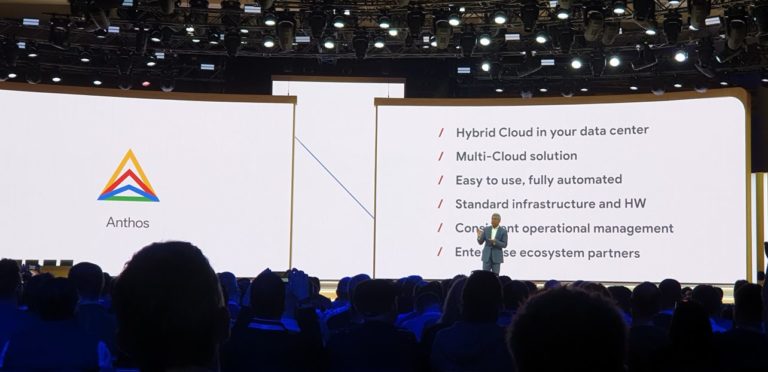During Google Cloud Next 2019, Google launched a new product called Anthos. Google Anthos is Google’s hybrid and multi-cloud strategy that companies have been waiting for. Azure has Azure Stack and AWS has a partnership with VMware. Google now passes by everything and everyone with Anthos. Anthos is platform-independent and can run anywhere. It is based on Kubernetes.
Google has done its homework on multi-cloud. Both Sundar Pichai, CEO of Google, and Thomas Kurian, CEO of Google Cloud, took the time to discuss Anthos. With Anthos, they are trying to achieve genuine multi-cloud possibilities. Research has shown that 88 percent of enterprise organizations want to adopt a real multi-cloud strategy. Whereas Microsoft and AWS hope to offer enough choice with a hybrid cloud strategy (Azure/Azure Stack and VMware), Google now chooses for the real multi-cloud.
Multi-cloud with Kubernetes
Anthos is based on the container platform Kubernetes, but it can run anywhere. Both on the Google Cloud Kubernetes platform and on third-party Kubernetes platforms. This means that Anthos can also run in Azure and Amazon Web Services, but also on-premise with Red Hat OpenShift, for example. Smaller cloud environments, such as IBM and Oracle, are also possible. The strength of Anthos is that containers are managed centrally. Security and access are also centrally controlled. Regardless of the platform, the containers work the same everywhere; developers don’t have to adjust anything to run them on a different platform. For operations, it is easy to move containers to other environments.
Migrating from virtual machine to container
For some IT professionals, this may sound good in theory, but it is still a bridge too far because building containers is not one of their specialties. It may also seem difficult to convert current virtual machines into containers. Google has found a solution for this in the form of Anthos Migrate, which has now gone into beta.
With Anthos Migrate, it is possible to convert an on-premise virtual machine to a Kubernetes container and to migrate it directly to the Google Cloud or another environment. This can be done within a few minutes with a simple command. Depending on the amount of data, it may take a little longer.
In this way, applications eventually become much more scalable. Some applications now run on infrastructure that is far too large for the average workload, because it must be possible to cope with any peaks in use. As soon as an application is running in a container, this is no longer necessary because it can be scaled up automatically. This often results in considerable cost savings.
Google has arranged Cisco, HPE and VMware as partners for Anthos.
Although Anthos is able to run containers out-of-the-box in any environment, Google cannot do this alone and needs partners. During the keynote, Cisco and VMware took the stage to explain their collaboration with Anthos, and we also received a press release in which HPE announced that it would support Anthos.
Cisco introduces Hybrid Architecture for Google Cloud, of which Anthos will be a part. In this way, the on-premise Cisco environment and the Google Cloud come together. Cisco announces that they will add support for Anthos to Cisco HyperFlex, HyperFlex Edge, Cisco ACI, Cisco Stealthwatch Cloud, Cisco SD-WAN and Cisco Intersight.
VMware has invested heavily in Kubernetes in recent years, even though it has a strong proposition with hybrid cloud plus virtual machines. At VMware, too, they realize that containers have a great future, but that virtual machines will never become superfluous. That is why it is important to be able to manage both VMs and containers via a single application. VMware will, therefore, support Anthos through vSphere, but also through Heptio, the Kubernetes platform that has been taken over by VMware.
HPE announced that it will introduce two verified infrastructure designs for Anthos. These designs are based on HPE SimpliVity Hyper-Converged Infrastructure, HPE Nimble Storage and HPE ProLiant servers.
In addition to Cisco, HPE and VMware, there are many other partners who are joining. Companies like Atos, Citrix, Dell EMC, F5 Networks, Intel, Lenovo, Palo Alto Networks and Splunk will also join Anthos. They’re all going to make their offerings compatible with Anthos.
It remains to be seen exactly how big Anthos will be, but the fact that so many companies want to join in immediately is a good sign.
